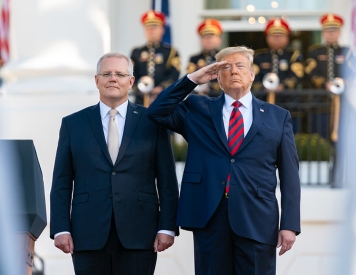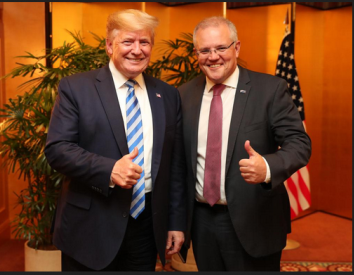If free education is good enough for Germany, Mexico and elsewhere, then it should be good enough for Australian students, writes Kellie Tranter.
WHY AREN’T YOU ANGRY?
You’re signed up for an expensive undergraduate degree that’s really just a meal ticket (if you’re lucky); you’ll have to find the money to pay fees and rent and survive for the years it takes to complete it; if you’re lucky enough to get a job you’ll come out on a salary that’s little more than average weekly earnings and you’ll face employment that’s insecure if not casualised. And you’ll probably have to accumulate a hefty debt for the privilege.
Your current education minister talks a lot, but the Eurocentric jingoistic education system he spruiks brings to mind Robin Boyd’s 'Diggerdom', where all men [and women] are of equal mental mediocrity. There’s never a mention of the benefits to individuals and society of education in its own right, and the possibility of a free undergraduate degree is no longer part of the discussion.
Why not?
Antonio Gramsci, known for his theory of cultural hegemony, stressed that
‘... a ruling class could not rule by violence, force or oppression alone, at least not for long: it must understand what we call today “soft power” and aim for cultural takeover…. This cannot be achieved overnight and requires that the potential class rulers undertake the long march through the institutions.’
The process has been happening over the last 25 years and the pace is only likely to accelerate under the Abbott Government.
With the national curriculum the first item for review on the educational agenda, it’s for the restless intellectuals among you to determine what the Government wants you to learn and why — and who is the ultimate beneficiary.
It was interesting that the new president of the National Union of Students, Deanna Taylor, said the Union will look at income support, privatisation of the Higher Education Contribution Scheme (HECS) debt and higher education quality this year. She indicated that key lobby targets include Clive Palmer because of his electoral promise for the abolition of all tertiary fees. (Then again, he also promised to bring back the long lunch!)
It’s sensible for the National Union of Students to target any person or party that may hold the balance of power, but isn’t it also time for the Union and students to question the status quo and review the economic ideology underpinning HECS?
Forty-two years ago, the Whitlam Labor government abolished fees at universities and colleges of advanced education because
'... education should be free.'
Fifteen years later, probably as a result of a neo-liberal ideological push from the U.S. and within the OECD, the Hawke Labor Government shifted its position in a ‘Higher Education a policy discussion paper’, published in December 1987.
The issues of concern could have been written yesterday: problems associated with the traditional export base, the sharp fall in world prices for traditional exports, and an adverse shift in the terms of trade requiring a change in the balance of the Australian economy away from traditional industries and towards the less familiar, such as advanced manufacturing and new service industries.
The discussion paper went on to note that
‘... significant barriers existed to the full participation of disadvantaged groups in higher education, that individuals from families with relatively low income levels draw less on the benefits of higher education than others and that groups such as Aboriginals face distinct advantages in terms of access.'
With the goal of expanding and reforming the higher education system, the Hawke Government was looking for contributions from individual students, former students and/or their parents.
It set up the Wran Committee with the following terms of reference:
§ The Government is committed to expanding the capacity and effectiveness of the higher education sector and to improving access to higher education for groups that are currently under-represented. This goal has significant funding implications…Given current and likely future budgetary circumstances, the Government believes that it is necessary to consider sources of funding involving the direct beneficiaries of higher education.
§ The Committee should develop options and make recommendations for possible schemes of funding which could involve contributions from higher education students, graduates, their parents and employers. In developing options the Committee should have regard to the social and educational consequences of the schemes under examination.
The Committee was not asked to look at whether there should be fees at all. With terms of reference predicated on fees being imposed, it’s easy to produce an economic argument to support the position of the government of the day rather than having to argue for that position from a number of properly assessed alternatives.
The theory underpinning HECS was that
‘... income contingent loans provided a gateway though which the university sector could be expanded to include many more students without sending the country broke. It resolved the equity dilemma of free university in that poor people paid university fees of the middle class via taxes providing advantaged students with a subsidised springboard.’
Now, this assumes that few poor people attend university and it’s a commonplace that the poor paying for anything – like paid maternity leave or the National Disability Support Scheme – creates similar equity dilemmas.
Yet, we also know that
‘... whoever defines the concept, names the target and shapes the vocabulary will win the battle of public opinion.’
In its July 1988 policy statement, the Hawke Government described access to education as vital and noted:
‘Education is one of the principal means for individuals to achieve independence, economic advancement and personal growth. But in the past the benefits of higher education have been enjoyed disproportionately by the more privileged members of our community. Those benefits need to be shared more widely and more equitably in the future.’
(I assume they’re excluding the period in which the Whitlam Labor Government made education free.)
In August 1988, the Government announced that it had accepted most of the Wran Committee’s recommendations and HECS was introduced on 1 January 1989.
Did the Wran Committee get it right?
Was the economic modelling sound having regard to its long term objectives? Have the stated objectives been achieved?
The National Union of Students’ needs its own Thomas Herndon to closely examine the economic modelling and arguments used to justify the introduction of the HECS.
If one of the long term objectives of HECS was for the full participation of disadvantaged groups, why do Indigenous students still only make up only 1 per cent of higher education enrolments in Australia?
And if the architects of HECS had regard to the social and educational consequences of the scheme, why is a recent student finance survey described as
‘... almost Dickensian in its presentation of students trying to cope with the demands of study and the need to find the money for food and clothing, not to mention shelter’?
The recent Grattan Institute report has found current and former students have accumulated Higher Education Loan Program (HELP) debts of $26.3 billion, up almost $10 billion since 2007. We don’t see any media discussion about the return to the government from students who graduate and go on to earn high salaries and pay higher taxes. Nor is there any informed discussion about the full-time job prospects for, and earning capacity of, university students who are now graduating in an era of labour hire, fixed contracts and casualisation.
In December 2013, the Greens fleetingly proposed the reintroduction of free university education for all Australian students, at a cost of $23 billion over four years: $15.4 billion in its first year, including $12.9 billion to cover the expense of forgiving the debts, and about $2.5 billion annually in subsequent years.
It’s time for domestic university students to place one eye on the future and demand free education for their initial degree.
Is $2.5 billion per annum really unaffordable, on a comprehensive cost-benefit analysis that takes into account more than just money?
The Government will claim that we all must “live within our means”, but they apply that rule rather selectively. If that’s the predictable retort then students should remind our government of its bailout funds for banks, which are private corporations, and they should point out that Chile’s President elect vowed – after 3 years of non-violent student protests - to reduce inequality in Chile by providing free education for all with $15.1 billion in extra spending.
If free education is good enough for Germany, Mexico and elsewhere, then it should be good enough for Australian students.
But it won’t happen unless students and their unions and supporters do their homework, speak out and take a stand.
Read more by Kellie Tranter on her blog kellietranter.com or follow her on Twitter @KellieTranter.

This work is licensed under a Creative Commons Attribution-NonCommercial-NoDerivs 3.0 Australia License
Support independent journalism Subscribe to IA.











